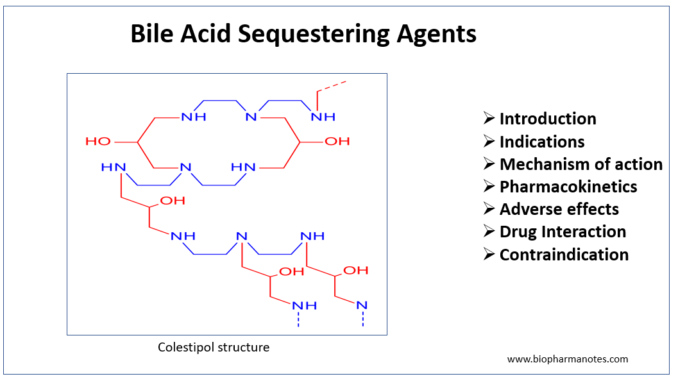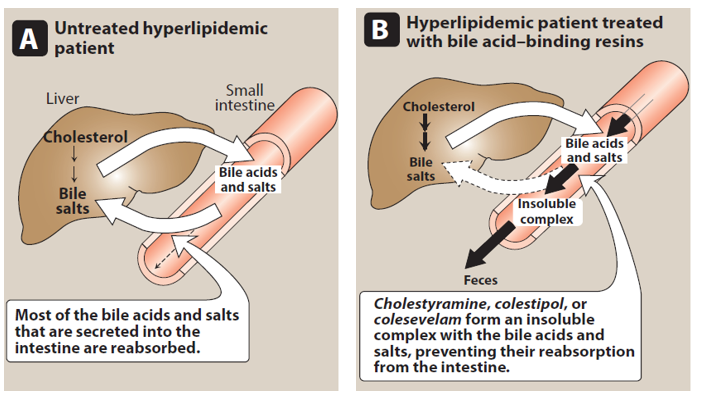
Bile acid sequestering agents
- Bile acid sequestering agent are hypolipidemic agents used to lower LDL cholesterol. Cholestyramine and colestipol are two established bile acid sequestrants and colesevelam are newer one.
Indications of Bile Acid Sequestering Agents
- They are used in combination with diet modification or other lipid lowering agents like niacin to treat type IIA and type IIB hyperlipidemias. They are used as second line agent if statin therapy is not effective in lowering LDL-C (Low- Density Lipoproteins).
- Cholestyramine is used in pruritus caused by accumulation of bile acid in patients with biliary stasis and cholestatic jaundice.
- Colesevelam is used in type 2 diabetes due to its blood glucose lowering property.
Mechanism of action of Bile Acid Sequestering Agents

Figure 1- Mechanism of action of bile acid sequestering agent (Source- Lippincott’s Illustrated Reviews)
- Cholestyramine and cholestipol are anion binding resin and colesevalam is polymer hydrogel binding agent. They have strong affinity for negatively charged bile salts and bile acids in intestine and hence bind with bile salts and acids. The bile acid-resin complex formed is excreted into feces resulting in decrease in bile acid concentration.
- To maintain the supply of bile acid, the metabolism of endogenous cholesterol to bile acid is increased in hepatocytes. Consequently, intracellular concentration of cholesterol decreases. This result in increased LDL receptor on liver cells and increased removal of cholesterol containing LDL particles from circulation. Hence, the ultimate effect is lowering of LDL-C.
Effects on lipid concentration
- They primarily lower LDL concentration. They have little effect on HLD and VLDL concentration. The VLDL level may increase transiently at the start of the therapy. The lowering of plasma triglyceride level is not significant.
Pharmacokinetics of Bile Acid Sequestering Agents
- They are insoluble in water, have large molecular weight. They are neither absorbed nor metabolized and are totally excreted in feces.
- Cholestyramine and colestipol are available as powder which should be mixed with water and taken as slurry. Colesevelam is available as solid tablet.
Adverse effects
- They are generally safe as they are not systemically absorbed. They can cause GI related side effects like nausea, vomiting, constipation and flatulence. Colesevalam has less GI related side effects than other two. Constipation can be avoided by increasing daily water intake.
- When used in large doses, they interfere with absorption of fat and fat-soluble vitamins and can cause steatorrhea.
Drug Interactions
- They may interfere with absorption of many other drugs like warfarin, thyroid hormone, tetracyclines and digoxin. So other drugs are taken 1-2 hour before or 4-6 hour after taking these agents.
Contraindications
- They may increase triglyceride level, so they are contraindicated in patients with hypertriglyceridemia.
References
- Pharmacology and Pharmacotherapeutics. 24th edition.
- Goodman and Gillman Manual of Pharmacology and Therapeutics.
- Lippincott Illustrated Reviews Pharmacology, 6th edition.
- https://www.ncbi.nlm.nih.gov/books/NBK549906/